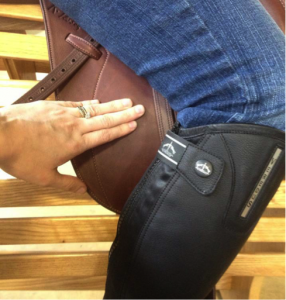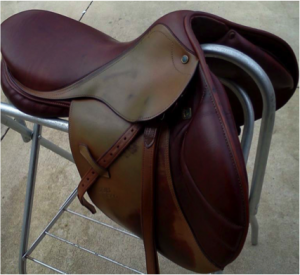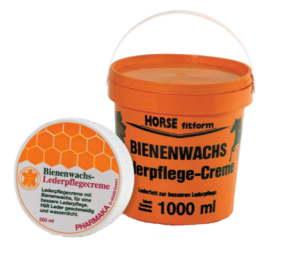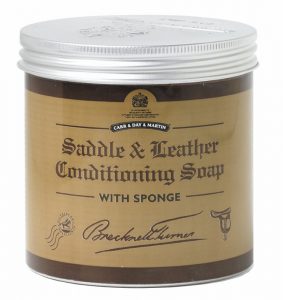Tips on Girth Sizing
Girth Sizing – With the shorter billets of many jumping saddles, it is important that a girth of a sufficient length is used so that the buckles of it will land high enough up on the billets. Basically, you want the buckles closer to behind the knee rather than right next to the rider’s calf. Besides being more comfortable for the rider (have you ever ridden with the buckles RIGHT under your lower leg?!), it will also eliminate excessive flap wear from buckle friction.
 The hand on the flap is placed directly on the buckles, showing how proper placement will not interfere with the leg or cause undue wear to the flap.
The hand on the flap is placed directly on the buckles, showing how proper placement will not interfere with the leg or cause undue wear to the flap.
Let’s Clean!
It is literally a question that we get DAILY from our customers, we figured it would be a good idea to cover it. As we all know, good tack is NOT cheap. If you are spending money on the good stuff, it only makes sense to treat them as an investment, and care for them accordingly, so that they can give you a good return. Additionally, the advents in tanning have changed the leather, making the “days of yore” care regime out of touch with modern leathers. There are 3 basic steps to caring for your fine leather goods: Cleaning, Conditioning and Safekeeping.
CLEANING: The easiest, most efficient way to clean your tack is to wipe it down with a damp sponge or cloth after every ride. It only takes a few minutes, and by doing so you eliminate the need to sit down and do an intensive cleaning once everything builds up. If daily maintenance is not your style and you REALLY need to clean your saddle, make sure you use a product that is specific to tack. Leathers used for furniture and clothing are tanned differently, so their care products are not necessarily interchangeable. Harsh cleaners may lift the dye from unsealed leathers. Most well known, commercially available tack cleaners are fine. Glycerin soap is safe to use, too – but you have to make sure to rinse the soap off, otherwise it will attract dust and dirt. If your leather somehow gets very, very dirty, resist the urge to use something abrasive, be it a sponge, cloth or brush, to speed the cleaning along. You will likely end up damaging the finish, if not the leather. Patience and a nubby terrycloth will take care of it eventually – hence why it is easier to do regular cleanings!
CONDITIONING: Conditioning is a balancing act – too little and your leather cracks, too much and you will actually change the makeup of the leather. There are oils and conditioners. Oil is easier to go “overboard” on, and doing so will actually cause the collagen fibers that make up the leather to weaken. When that occurs, it makes everything prone to stretching, and possible breakage. Basically, it’s unsafe. Leather that is as floppy as a sock has been over-oiled. Conditioners are a bit more user friendly, and a bit harder to over-do. They contain a blend of oil, waxes and beneficial fats. Either product should be applied in THIN coats when needed, to keep the leather supple. Thick coats won’t absorb, and will either transfer to your breeches and saddle pads, or get sort of crusty and form a scaly, chalky buildup, especially on printed leathers. You will know when your leather needs conditioning by the feel of it – think of it like skin, and if it looks chalky and dry, it most likely needs to be treated. How often you ride, the conditions while you ride and your general climate will impact how often this will occur. 
SAFEKEEPING A great way to keep your eye on stitching, leather cracking or other problems is during your daily tack wipe down. And you thought it was just about keeping things clean! But by finding any problems early on, the repair of such issues is generally easier (and cheaper!) to deal with. Regarding storage, keep your tack out of direct sun, in a well-ventilated, non-humid and, preferably, climate controlled area. Humidity is the main reasons for mold, and temperature swings can really dry out your leather. Also hang or store your tack where the resident cats can’t climb/ nap on it, or the dogs/ goats/ donkeys can’t reach it to turn it into a chew toy. If you store your tack for an extended period you may notice a white film forming on the surface. This most often happens to saddles in cooler climates. This is most likely not mold or mildew, but something that is nicknamed “saddler’s bloom”, which is basically the fats present in quality leather. When you are using your saddle regularly, the friction rubs the fats back into the leather, so it’s not seen. Rubbing with a cloth will remove the residue; you can accelerate the process by bringing the leather goods into a warmer room – it helps absorption.
Urban Tack Cleaning Legends So, now that we know the proper way to care for our precious leather goods, let’s revisit some of the best “old wives’ tales” of tack care! “Let’s take the waxy white stuff off with some ammonia” That’s great, it will be so stiff it can stand up straight by itself! One of the most well known, incorrect procedures was to ’strip ‘any new piece of tack with ammonia to take the white waxy residue off. This residue is part of the tanning process and will easily dissolve with the first conditioning. Using the ammonia at the outset is just taking all the oils right out of the leather. Another Urban Legend is… “To oil the saddle properly, heat the oil to a high temperature and then soak the saddle in it” Basically you are cooking and destroying the fibers in the leather. In the end you will have a piece of equipment (bridle or saddle) that will not last. Fibers in leather will be damaged and destroyed , causing easy breakage.
Old Wives’ Tales for Leather Care “I need to oil my saddle at least once a month” Great idea if you want to ride on a large squishy rubber band. Even if the saddle is dried out, use conditioner. The oil keeps getting absorbed until the pores of the leather are just busting out with oil. Eventually pores are clogged and the leather is ruined. “I think I will oil my tack with baby oil.” Oh Baby, that is just wrong. Baby Oil is basically mineral oil, which is a petroleum by-product. Scent and other things are added. Once again the pores of the leather will be clogged. And by the way, they are now not even recommending it for babies any more. “I just got a new saddle. I want it darker and think that I will put some olive oil on it.” Even if the Olive Oil is Like a Virgin, put it on your salad and not on your saddle! The olive oil can react with the dyes from the tanning process, turning your saddle a nice ORANGE or sometimes GREEN, not darker!Please use products that are made for leather. The chemicals in it will not react unpleasantly with the leather. Old Wives’ Tales for Leather Care last, but not least, we tell you a true story of someone not using a proper product. A rider (NOT a beginner, by the way!) got a brand new, very expensive saddle and decided to oil it with butter. She left it on a rail out in the sun to let the butter heat up and soak in. One of the barn dogs got the scent… and we are sure you can guess the ending. Yes, the saddle was partially consumed by the nice, sweet stable dog!! So please, there are plenty of products out there to use that are specifically for leather tanned for saddle use. The products that we carry and recommend we have used and tested. For the good of your tack, use them – and not something from the pantry!

Saddle that was cleaned and conditioned with “pantry products”, causing the leather to lose its color and turn a greenish-orange.
Taken from
English Riding Supply
All about Saddles Newsletter
May 2013






Recent Comments